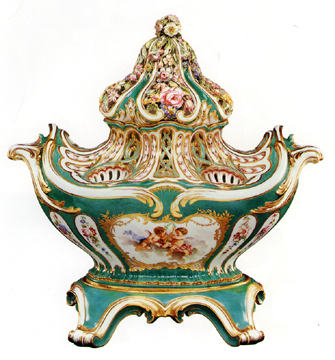
Pot Pourri Container, Sèvres Porcelain, France 1760 CE
Porcelain with overglaze enamel and luster
ART 198 - HISTORY OF WORLD CERAMICS
| This elaborate pot pourri container, made at the Royal Porcelain Factory at Sèvres in the early 1800's is a classic example of the 'over-the-top' opulence of the rococo era. Works made under the influence of the rococo were intended for the salons of the rich and powerful in Parisian society to showcase their wealth and taste. This piece, designed by Jean Claude Duplessis, a silversmith, betrays its design origins by the treatments of the feet and handles, which clearly echo hia designs in silver. The upper portion of the container is perforated, to allow the fragrance of the pot pourri to scent the rooms in which these were placed. This example is from the collection of Madame DuPompadour, mistress of Louis XV. It was her influence that caused Louis to finance the production of the Sevres factory, given her love of the porcelains produced there. For hundreds of years, the royal houses of Europe had spent lavish sums on imported Chinese porcelains, but with the European discovery of Porcelain in 1709 at Meissen by Johann Bottger, the rage was on in Europe for local production. First at Meissen by Augustus the Strong of Bavaria, and soon after by Louis XV at Sèvres, the European monarchs strove to outdo each other with lavish designs commissioned for their royal apartments. | Pot Pourri Container, Sèvres Porcelain, France 1760 CE Porcelain with overglaze enamel and luster |
|
|